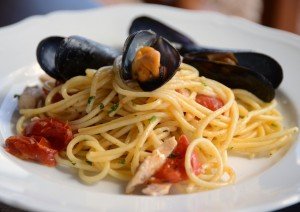Top Four Reasons to Travel to Bordeaux!
December 6, 2024
Bordeaux is well known for being the wine capital of the world, and with good reason. Bordeaux produces at least 400 million liters of -…
Read This Post Traditional Italian food often features fresh, seasonal ingredients straight from the market. But when it comes to reading the menu, whether you’re dining in an osteria, trattoria, or Michelin-star ristorante, how do you know what you’re ordering?
Traditional Italian food often features fresh, seasonal ingredients straight from the market. But when it comes to reading the menu, whether you’re dining in an osteria, trattoria, or Michelin-star ristorante, how do you know what you’re ordering?
Many Italian dishes, which you’ll learn more about in our cooking classes – such as the market visit and class with Chef Barbara in Florence – include ingredients that most Americans are familiar with, like mozzarella and various kinds of pastas. What is less familiar is how Italians arrange their menu.
Discover all our amazing cooking vacations in Italy.
 Start with l’antipasto or antipasti (appetizers), which literally translates to “before the meal.” As in America, Italians love to start their meal with a small plate of food such as bruschetta, insalata caprese (mozzarella and tomato salad), or a plate of salumi. If you’d like to split your appetizer with whomever you’re dining with, just let your waiter know, and they’ll bring you a second plate.
Start with l’antipasto or antipasti (appetizers), which literally translates to “before the meal.” As in America, Italians love to start their meal with a small plate of food such as bruschetta, insalata caprese (mozzarella and tomato salad), or a plate of salumi. If you’d like to split your appetizer with whomever you’re dining with, just let your waiter know, and they’ll bring you a second plate.
Check out our one-day classes in Italy.
 Next up is the primo piatto, or primi, which is the pasta course. Unlike in the U.S., the serving size of the pasta is almost always a smaller portion, as this course is then followed by the main course. Other dishes that may be listed under the primi include gnocchi, risotto, and soups.
Next up is the primo piatto, or primi, which is the pasta course. Unlike in the U.S., the serving size of the pasta is almost always a smaller portion, as this course is then followed by the main course. Other dishes that may be listed under the primi include gnocchi, risotto, and soups.
The secondo piatto (or secondi) features the main course or entree, usually meat, fish, or game.
 Contorno means side dish; these are ordered a la carte and served with your secondo. Often, the contorno options are either seasonal vegetables (verdurre di stagione) or green salad (insalata verde). Don’t expect the server to ask you what type of dressing you want if you order a salad, as they will bring you olive oil and vinegar and let you dress it yourself.
Contorno means side dish; these are ordered a la carte and served with your secondo. Often, the contorno options are either seasonal vegetables (verdurre di stagione) or green salad (insalata verde). Don’t expect the server to ask you what type of dressing you want if you order a salad, as they will bring you olive oil and vinegar and let you dress it yourself.
Formaggi, or cheeses, are also typically listed as a separate menu section in Italy. The formaggio course often highlights local, artisan cheeses that are specific to the region. This is served as its own course.
 Lastly, i dolci are the sweetest part of the menu: dessert (the singular form – dolce – is the Italian word for “sweet”). These sweet treats often vary from region to region in Italy. During our culinary vacation in Norcia, delight your tastebuds with housemade ricotta dipped in honey. During Cook Under the Tuscan Sun, enjoy such desserts as cream soffiata al limone, or lemon cream, which is often paired with fresh fruit. Some classic desserts, such as tiramisú and torta della nonna, can be found throughout Italy.
Lastly, i dolci are the sweetest part of the menu: dessert (the singular form – dolce – is the Italian word for “sweet”). These sweet treats often vary from region to region in Italy. During our culinary vacation in Norcia, delight your tastebuds with housemade ricotta dipped in honey. During Cook Under the Tuscan Sun, enjoy such desserts as cream soffiata al limone, or lemon cream, which is often paired with fresh fruit. Some classic desserts, such as tiramisú and torta della nonna, can be found throughout Italy.
See five tips for dining out in Italy.
Italian menus feature many courses, but don’t feel pressured to order from every part of the menu. While serving sizes are more reasonable in Italy compared to the U.S., they still are very filling. But the progression of the meal is designed to make it all manageable, and with the delicious flavor combinations, it may be difficult to order just one or two courses!
Learn more about dining out in Italy:
Buon appetito!
By Peg Kern
Find more photos, videos, food facts, and travel stories from The International Kitchen on Facebook, Instagram, Pinterest, Twitter, and YouTube.
Sign up to receive our newsletter, which includes travel tips, recipes, promotions, and information on our best cooking vacations.
Originally published January 25, 2013.